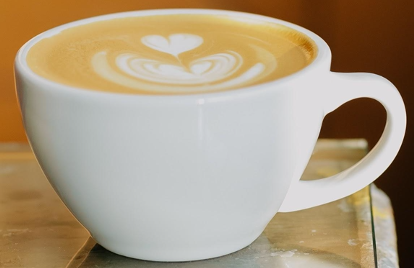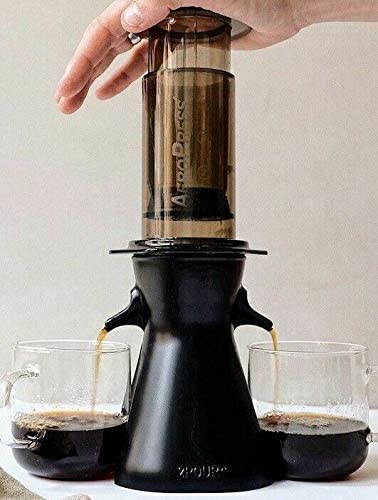Designed to make a lot of coffee with little fuss, the percolator is simple, convenient, and more old-fashioned means of brewing a coffee. Invented in the 1880’s, this is probably how our forefathers made their coffee, up until the 1970’s of course when the electric drip coffee maker and instant coffee became kitchen fixtures.
How Does a Percolator Make Coffee?
Outside, the coffee percolator looks no different from a regular kettle. Inside however, is a different story. Instead of a single chamber, the percolator has two — a bottom chamber for the water and a top chamber for the coffee grounds. Running through the middle is a vertical tube where the heated water from the bottom travels upwards to flow over the grounds, effectively brewing the coffee. The brewed coffee then collects at the same bottom chamber that used to hold plain water.
As long as the heat is on, whatever liquid is there will continue to cycle upwards and flow over the grounds again. This is why the percolator is notorious for producing bitter, over extracted coffee. There are of course, ways to avoid this from happening.
How is the percolator different from a moka pot like the Bialetti?
A moka pot has a different structure from the regular stove-top percolator. It has three chambers instead of two: the bottom for water, the middle for the grounds, and a completely separate top chamber where the brewed coffee is collected. The boiling water is pushed up through a tube into the middle chamber, soaking the grounds from under, then continues to shoot upwards and flow into the top chamber. The coffee doesn’t flow back to the bottom so there is no risk of it going through the grounds again. The moka pot produces thicker, more espresso-like coffee than the regular percolator.
Brewing Coffee With a Percolator
It’s pretty straightforward to make coffee using a percolator. You don’t really have to learn any complicated techniques but you have to know what kind of coffee you’re using and you have to be mindful of the brewing time.
Start by taking the basket and tube system out and pouring water to fill the lowest chamber. The recommended water-coffee ratio is 500 grams of water to every every 30 grams of coffee. Next, place the basket and tube back to the pot and add medium-coarse coffee grounds into the basket. Remember that the finer the grind, the stronger the coffee. And because you don’t have as much control over this brewing process, a coarser grind will be more forgiving.
Finally, light up! Onto the stovetop the percolator goes and turn on medium heat. You don’t want the water to heat too quickly or to boil too furiously. Rather, the goal is for the water to bubble its way up to the tube. Electric percolators typically have one heat setting which is already optimal for this kind of brewing so all you need to do is switch it on.
Let the coffee percolate for 5-10 minutes. Observe that brew — the darker the liquid that spouts out of the tube, the stronger (or more bitter) the flavor is. An optional step that you can take for a cleaner cup of coffee is by filtering the liquid through a regular paper filter before serving. Enjoy!
Kinds of Percolators
Percolators are often interchanged with moka pots but these two are different, like we explained previously. Still, there are two kinds of percolators: stovetop and electric.
Stove top percolators rely on a separate heat source to start brewing. Some pots are compatible both for traditional stove tops and induction heaters, while others may not be induction-ready but are extra durable and can handle direct heat from a campfire.
Electric percolators, on the other hand, have a built-in heating mechanism. You just have to plug them in and off you go.
So which one should you pick? This depends on your intended usage. If you’re camping out a lot, get the sturdiest pot you can find that has insulated handles. If you’re pretty much indoors all the time, it’s a toss-up between stovetop and electric.
5 of the Best Percolators on Amazon
| Percolator | Induction Ready? | Capacity | Features | Amazon Rating |
| Farberware Classic Stainless Steel Yosemite 8-Cup Coffee Percolator | Yes | 8 cups / 12 cups | Non-reactive metalDishwasher-safe | 4.5/5 |
| Coleman 9 Cup Coffee Percolator | No | 9 cups | Bail handleCan handle direct heat | 4.3/5 |
| Cook N Home 8-Cup Stainless Steel Stovetop Coffee Percolator | No | 8 cups | Non-reactive metalExtra filter on coffee basket | 4.6/5 |
| Farberware 8-Cup Electric Percolator | No | 8 cups | ElectricDetachable cord | 4.4/5 |
| Stanley Cool Grip Camp Percolator | No | 6 cups | Brushed steel exteriorCan handle direct heat | 4.3/5 |
Farberware Classic Stainless Steel Yosemite 8-Cup Coffee Percolator
https://www.amazon.com.au/Farberware-Classic-Stainless-Yosemite-Percolator/dp/B00005NCWQ
Described as a beast in many of its reviews, we can’t help but agree because the Faberware Yosemite has a sturdy stainless steel build, a thick plastic handle, and a clear plastic knob so you can see into the pot while brewing. Inside, it has a non-reactive surface which prevents it from absorbing or developing unpleasant odors that can ruin your morning cuppa.
This percolator is likely to be a mainstay in your kitchen because a few other things:
It has a large capacity (choose from 8-cup or 12-cup).
It is dishwasher-safe.
It is compatible with a traditional stovetop and an induction oven.
If there is one thing to be careful with the Yosemite, it’s the knob. Some people find this to be a weak spot – but it’s also possible that these people were brewing on a very high heat setting.
Coleman 9 Cup Coffee Percolator
https://www.amazon.com.au/Coleman-9-Cup-Coffee-Percolator/dp/B00168YEQ6/
If you are looking for something to take outdoors, this Coleman percolator has the perfect rustic look and durability for direct heat. Made with aluminium, it is lightweight, rust-resistant, but tough. It won’t weigh down your already backbreaking backpack but you can make nine cups of coffee with it!
Unlike other camping percolators available on the market these days, this rugged Coleman has a bail handle that’s strongly reminiscent of ancient but well-loved camping cooking gear. The bail handle is versatile and will work with various heating setups when outdoors: over the grill, over butane, over fire, etc. Worried about spillage when pouring? There is also another handle on the side of the pot that gives you better control.
Cook N Home 8-Cup Stainless Steel Stovetop Coffee Percolator
https://www.amazon.com.au/8-Cup-Stainless-Stovetop-Coffee-Percolator/dp/B074WC9QTJ/
This Cook N Home percolator has a classic mirrored exterior that looks handsome on any countertop. Its design is aesthetically pleasing and functional as well: a clear knob that lets you look into the pot, a sturdy, well-insulated handle, and a drip-free spout. It also retains heat exceptionally well.
Inside, the steel is non-reactive and won’t absorb odors or develop a metallic taste over time. What makes this percolator stand out is the design of its coffee basket: the holes are covered, preventing the grounds from mixing in with the brewed coffee.
Farberware 8-Cup Electric Percolator
https://www.amazon.com.au/Farberware-8-Cup-Percolator-Stainless-FCP280/dp/B00004R946/
The first electric option on this list also comes from Faberware, a trusted brand. A construction of stainless steel and hardy plastic, this percolator is stylish and perfect for everyday use. The cord is detachable to make serving coffee on the table easy. It also has a keep-warm function that lets you enjoy the entire pot to its last drop.
If there’s something that we feel is lacking in Faberware’s electric option, it’s the see-through top. You can’t see into this pot while brewing. However, because this is electric, you don’t really have to but still, we miss the visual aspect of percolating.
Stanley Cool Grip Camp Percolator
https://www.amazon.com.au/Stanley-Cool-Grip-Camp-Percolator/dp/B07QKF1V3M/
Made with stainless steel, this Stanley percolator is rust-proof and travel-ready. For a camping percolator, it looks gorgeous: brushed steel exteriors, a clear knob, and a well-designed spout that pours perfectly. And its silicone handle is removable in case you need to heat directly over fire. We absolutely love that if we decide to use this in the kitchen instead of outdoors, it won’t look out of place on the kitchen counter.
Though there’s nothing special about the design inside, the material used allows the pot to keep coffee hot for almost four hours and can also keep cool drinks cool for nine. That’s quite a feat isn’t it?
So which percolator do I buy?
Despite the arrival of many shiny new coffee makers, the percolator maintains a loyal following because of its simplicity. Many reviewers are nostalgic of the heavy build of percolators from the past and are a tad disappointed with today’s options. That doesn’t mean that what you’ll find on Amazon are lacking though — these options can still last you years but don’t expect decades of service. They just don’t make them like they used to.
Among our top 5, the Faberware Yosemite is our favourite. It has all you’ll need in a percolator: odour-resistant, sturdy, large-capacity, dishwasher-safe, and induction-ready. What more can you ask for?
For travel, we like the Coleman for its bail handle and light, durable body. Put it on the grill, over direct fire, or a butane burner and it’s still alright.




